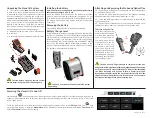
SA-3052A
Owner’s Manual
8-3
®
Monitor Speaker Equalization
Monitors in this context are the monitors used in a recording studio for monitoring
and evaluating the program being recorded. Equalization in this context is especially crit-
ical because any response aberration in the control room monitor speakers has an inverse
relationship on the material being monitored once the material is removed from the room
and played on other equipment.
Consider: Your playback system has a midrange bump in it around 3kHz, and a
fairly flat high-end. You’re mixing some material down using these speakers as a refer
-
ence. When the producer takes the material out of the studio and listens to it that night at
home, he notes that the vocals didn’t seem quite as present as they were at the studio and
that the drums seem a bit lifeless.
What has happened is that the 3k bump caused you pull the vocals down in the
mix (since most vocal energy is around 3k) and the flat high-end resulted in not having
enough treble energy content in the final mix. This occurs partially from a level judgment
error (too much top end in the monitors, not enough on tape) and perhaps from an equal-
ization error (it sounded fine in the monitors, why EQ it?).
If the speakers have a bass bump, then your end-product could be bass shy. As you
can see, the speakers really do have an inverse effect on your end-product.
Careful equalization of your monitor system using the SA-3052A and a good equal-
izer can give your studio the ability to make tapes that sound good anywhere. The process
and pitfalls are very similar to equalizing a home hi-fi system. Additionally you should be
aware of the following:
• Your microphone positions should be approximately where the engineer sits, at
approximately head level. It’s not a bad idea to use several positions at approxi
mately ear level, but along the length of the console. Make sure that the response
at the producer’s chair is very similar to that at the engineer’s chair.
• Make the overall response curve smooth rather than flat.
• Add some controlled rolloff at the high frequencies to compensate for the rolled-
off high-frequency response of most home systems.
• Pay attention to the response in the midrange of the audio spectrum, between
300 Hz and 5KHz. Make sure that it is smooth and reasonably flat.
• Do flatten peaks.
• Do remove shallow, wide bandwidth holes.
• Do not remove large holes of any bandwidth.
• Beware of adding large amounts of boost at low frequencies. Unless you have
infinite amplifier power and speakers capable of moving infinitely far, this is an
invitation to amplifier clipping or speaker destruction.
•
Remember that 3 dB of boost requires twice the amplifier power at that frequency.
Chapter 8 - Applications
Содержание SA-3052A
Страница 2: ...SA 3052A Owner s Manual ...
Страница 4: ...SA 3052A Owner s Manual ...
Страница 30: ...SA 3052A Owner s Manual 5 4 ...
Страница 50: ...SA 3052A Owner s Manual 7 6 ...
Страница 58: ...SA 3052A Owner s Manual 8 8 ...












































